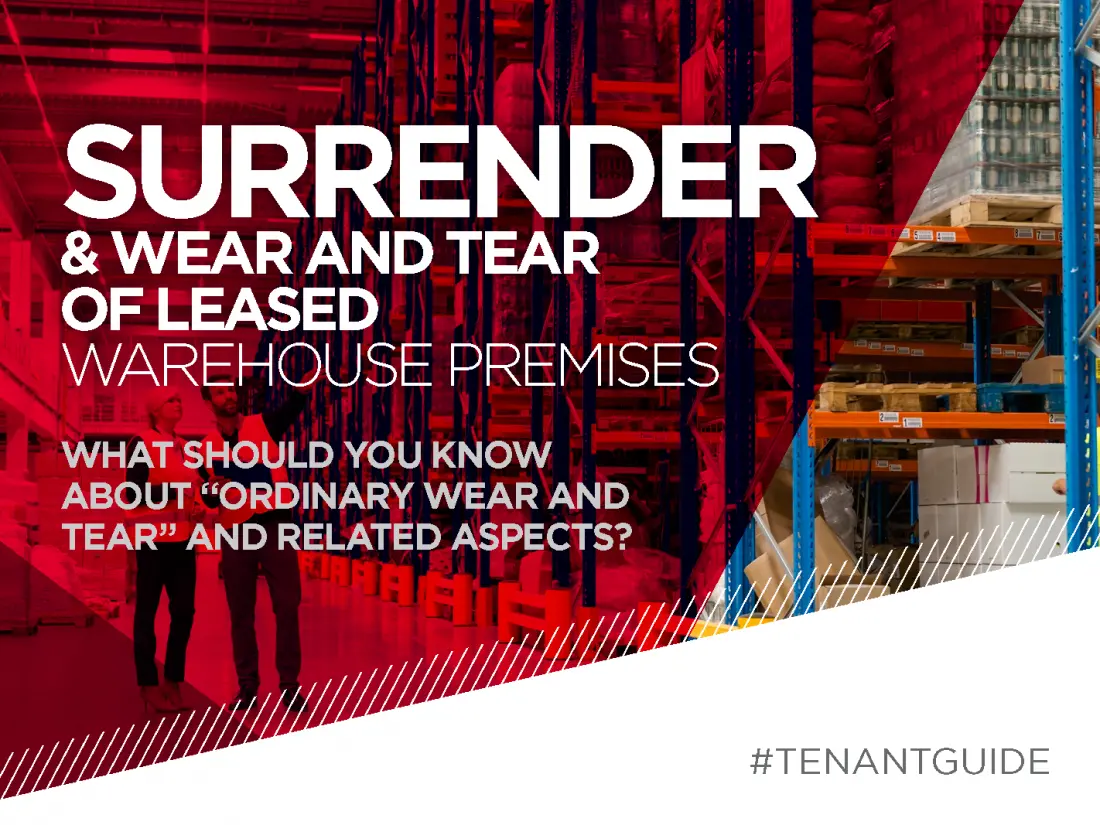Warehouses. Surrender and ordinary wear and tear of leased premises
02 november 2020

Contents
Despite being important, conditions for surrender of leased premises are frequently overlooked during the negotiations of a lease agreement:
“The tenant shall surrender to the landlord the leased premises in a condition resulting from the tenant’s obligations set out in the lease, i.e. in a condition corresponding to that of the date of signing the delivery report on the commencement date, subject to ordinary wear and tear”
and that:
“The landlord may require the tenant to restore the leased premises to the condition as on the date of their delivery to the tenant on the commencement date, subject to ordinary wear and tear”
This matter is important, because our experience shows that interpretation discrepancies between the landlord and the tenant may be huge and result in considerable costs. And sometimes it will take a long time to negotiate with the landlord the final scope of works, their delivery method and final costs.
Costs related to warehouse lease premises
Such costs may also substantially impact on the conclusions of analyses of lease renewal or relocation options. They can make relocation significantly less cost-effective or entirely unprofitable despite offers of other landlords appearing more attractive in comparison with the tenant’s current lease. The costs of surrender of leased premises can, in a way, safeguard the landlord against the tenant moving out.
The main reason for this is that the term "ordinary wear and tear" is interpreted freely - although upon signing of a lease agreement it appears well-defined, practice shows that the same interpretation of the term is rare when it comes to lease termination.
What to remember when signing a warehouse lease agreement?
It is therefore critical that the term "ordinary wear and tear resulting from the ordinary use of leased premises" be clearly specified during lease negotiations. tenants who will dedicate some time and energy to this issue during lease negotiations will enjoy clarity and be able to avoid additional costs when they finally decide to vacate a facility.
Precise specification will consist in determining what constitutes ‘reasonable’ wear and tear of individual elements and will have to cover the key parts of leased premises, including such items as:
Warehouse space:
| Floor | In respect of such items as: floor chips, stains or cracks, discolouring, scratches or stains made by the tenant’s forklifts, holes left by the tenant’s items, the tenant’s signage on the floor. |
| Sandwich walls | In respect of such items as: dirt, dents, abrasions, chips, scratches, as well as holes left by the tenant’s items. |
| Masonry walls and drywalls | In respect of such items as: dirt, dents, abrasions, chips and scratches on masonry walls and drywalls, holes left by the tenant’s items. |
| Docks (ramps and doors) and grade level doors | In respect of such items as: dents, abrasions and scratches on door panels, working condition of doors and ramps, damage to bumpers, skirtings, etc., wear and tear of bearings, shafts, rollers, corrosion of the platform structure. |
| Bumpers and safety barriers | In respect of such items as: dents, abrasions and scratches. |
| Lighting | In respect of such items as: replacement of lights that are damaged and/or have reduced lighting output; damaged light fixtures. |
| Forklift charging stations | In respect of such items as: damage to electrical and ventilation systems, chips, stains and scratches on epoxy floor coating or walls. |
| Fire hose reel cabinets | In respect of such items as: mechanical damage, scrapes and scratches. |
| Window and door joinery | In respect of such items as: dents, scrapes and scratches, and working condition, as well as marks left by the tenant’s items. |
| Fire doors and emergency exits | In respect of such items as: dents, scrapes and scratches, and working condition, as well as marks left by the tenant’s items. |
Office and social space:
| Floor | In respect of such items as: dirt, stains, abrasions, damage to and discolouring of fitted carpets and PVC flooring. |
| Walls | In respect of such items as: dirt, dents, abrasions, damage to and scratches on masonry walls and drywalls, holes left by the tenant’s items. |
| Wall and floor tiles | In respect of such items as: abrasions, chips and scratches, holes left by the tenant’s items, cracked grout and silicone caulks. |
| Sanitary ceramic ware and fittings in toilets and shower cubicles | In respect of such items as: damage to and wear and tear of washbasins, toilet bowls, dispensers and other sanitary ware and fixtures. |
| Ceilings | In respect of such items as: damage to and dirt on ceiling tiles and structures. |
| Window and door joinery | In respect of such items as: dents, scrapes and scratches, and working condition, as well as marks left by the tenant’s items. |
Exterior:
| Pavers and concrete | In respect of such items as: chips, stains and scratches on pavers/concrete, discolouring, scratches or stains made by the tenant, holes left by the tenant’s items, the tenant’s signage on the pavers/concrete. |
| External walls and sills | In respect of such items as: dirt, dents, abrasions, damage to and scratches on sandwich panels and sills. |
| External balustrades | In respect of such items as: dents, abrasions, paint peeling off, and scratches. |
| Equipment and structures for rooftop equipment | In respect of such items as: disassembly of structures, hole patching, etc. |
Another key issue is to determine which improvements to the leased premises made by the tenant or by the landlord for the tenant must be removed by the tenant and which may remain upon surrender of the leased premises, as this may impact cost levels.


